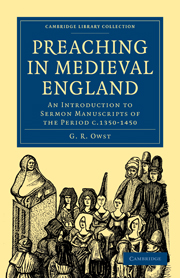Book contents
- Frontmatter
- GENERAL PREFACE
- AUTHOR'S PREFACE
- Contents
- ILLUSTRATIONS
- PART ONE THE PREACHERS
- PART TWO THE PREACHING SCENE
- PART THREE THE SERMONS
- CHAP. VI THE SERMON LITERATURE AND ITS TYPES
- CHAP. VII MANUALS AND TREATISES
- CHAP. VIII SERMON-MAKING, OR THE THEORY AND PRACTICE OF SACRED ELOQUENCE
- APPENDICES
- INDEX
- Plate section
CHAP. VIII - SERMON-MAKING, OR THE THEORY AND PRACTICE OF SACRED ELOQUENCE
Published online by Cambridge University Press: 07 September 2010
- Frontmatter
- GENERAL PREFACE
- AUTHOR'S PREFACE
- Contents
- ILLUSTRATIONS
- PART ONE THE PREACHERS
- PART TWO THE PREACHING SCENE
- PART THREE THE SERMONS
- CHAP. VI THE SERMON LITERATURE AND ITS TYPES
- CHAP. VII MANUALS AND TREATISES
- CHAP. VIII SERMON-MAKING, OR THE THEORY AND PRACTICE OF SACRED ELOQUENCE
- APPENDICES
- INDEX
- Plate section
Summary
Of the several impressions left upon the mind, after a first survey of mediaeval sermon literature, that which is most likely to attract the reader further will be concerned with the sacred eloquence of the special occasions, or the words directed to some particular class of the community with their reference to current habit and idea. If he holds to the pursuit at all, he will henceforth be impatient to follow up suggestive tracks observed to lead whither a more familiar literature was leading him already; or to be away down the wind after fresh quarry like the ecclesiastical revelations we have sighted. True it is that the hunting over these much despised literary preserves may not prove as bad as some imagine. For what game there is has really been little disturbed as yet, and here fortunately the less painstaking huntsmen of letters do not venture as a rule. Conscientious research, on the other hand, requires that, before the pleasures of the chase, there shall be some preliminary groundwork. However dull the task, we must proceed to examine the various modes of actual sermon construction.
Three great influences in the matter of style can be detected at work among the sermon-types which found their place in the previous chapters. Ever since the thirteenth century, at least, they had stood offering their services, as it were, to the would-be preacher, waiting upon him not like the three friendly graces with linked arms, that Master Rypon describes, but rather as jealous rivals, each claiming from him an exclusive choice.
- Type
- Chapter
- Information
- Preaching in Medieval EnglandAn Introduction to Sermon Manuscripts of the Period c.1350–1450, pp. 309 - 354Publisher: Cambridge University PressPrint publication year: 2010First published in: 1926



